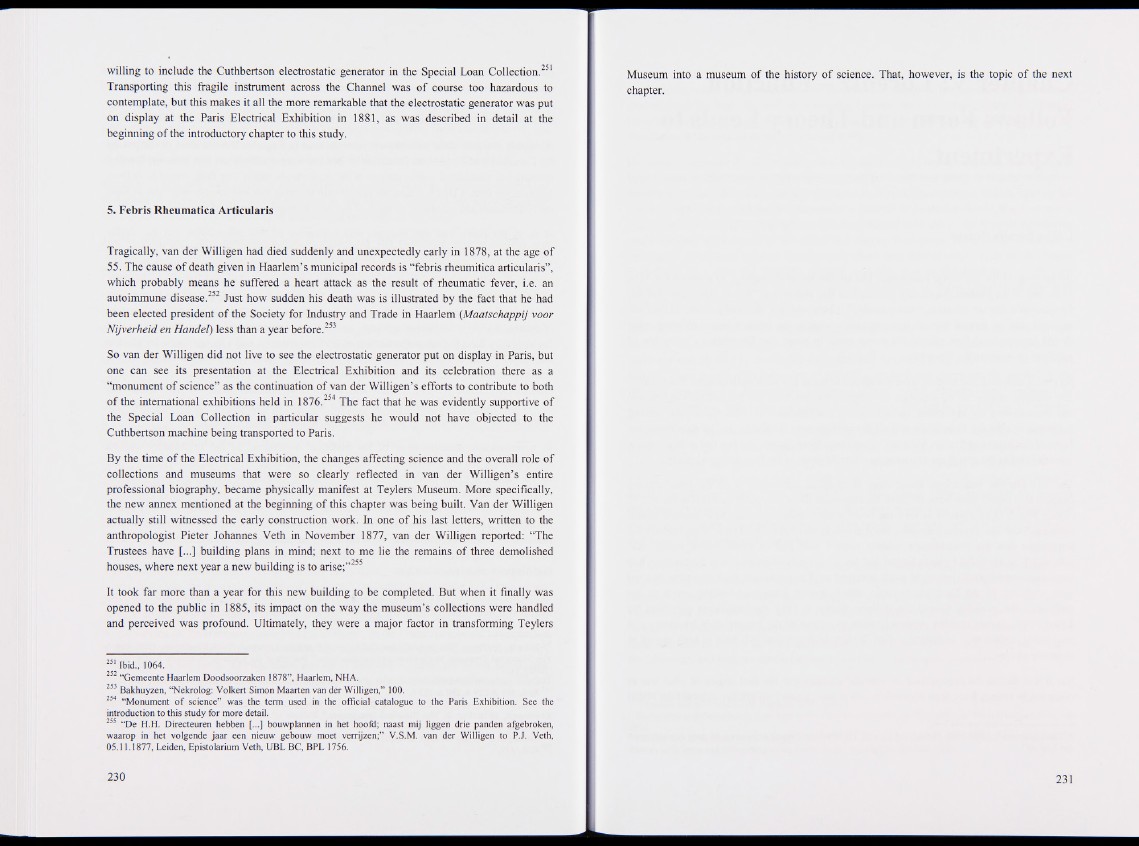
willing to include the Cuthbertson electrostatic generator in the Special Loan Collection.251
Transporting this fragile instrument across the Channel was of course too hazardous to
contemplate, but this makes it all the more remarkable that the electrostatic generator was put
on display at the Paris Electrical Exhibition in 1881, as was described in detail at the
beginning of the introductory chapter to this study.
5. Febris Rheumatica Articularis
Tragically, van der Willigen had died suddenly and unexpectedly early in 1878, at the age of
55. The cause of death given in Haarlem’s municipal records is “febris rheumitica articularis”,
which probably means he suffered a heart attack as the result of rheumatic fever, i.e. an
autoimmune disease.252 Just how sudden his death was is illustrated by the fact that he had
been elected president of the Society for Industry and Trade in Haarlem (Maatschappij voor
Nijverheid en Handel) less than a year before.25
So van der Willigen did not live to see the electrostatic generator put on display in Paris, but
one can see its presentation at the Electrical Exhibition and its celebration there as a
“monument of science” as the continuation of van der Willigen’s efforts to contribute to both
of the international exhibitions held in 1876.254 The fact that he was evidently supportive of
the Special Loan Collection in particular suggests he would not have objected to the
Cuthbertson machine being transported to Paris.
By the time of the Electrical Exhibition, the changes affecting science and the overall role of
collections and museums that were so clearly reflected in van der Willigen’s entire
professional biography, became physically manifest at Teylers Museum. More specifically,
the new annex mentioned at the beginning of this chapter was being built. Van der Willigen
actually still witnessed the early construction work. In one of his last letters, written to the
anthropologist Pieter Johannes Veth in November 1877, van der Willigen reported: “The
Trustees have [...] building plans in mind; next to me lie the remains of three demolished
houses, where next year a new building is to arise;”255
It took far more than a year for this new building to be completed. But when it finally was
opened to the public in 1885, its impact on the way the museum’s collections were handled
and perceived was profound. Ultimately, they were a major factor in transforming Teylers
2Î1 Ibid., 1064.
2 “Gemeente Haarlem Doodsoorzaken 1878”, Haarlem, NHA.
253 Bakhuyzen, “Nekrolog: Volkert Simon Maarten van der Willigen,” 100.
254 “Monument o f science” was the term used in the official catalogue to the Paris Exhibition. See the
introduction to this study for more detail.
255 “De H.H. Directeuren hebben [...] bouwplannen in het hoofd; naast mij liggen drie panden afgebroken,
waarop in het volgende jaar een nieuw gebouw moet verrijzen;” V.S.M. van der Willigen to P.J. Veth,
05.11.1877, Leiden, Epistolarium Veth, UBL BC, BPL 1756.
Museum into a museum of the history of science. That, however, is the topic of the next
chapter.